Back to Don's Maps
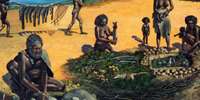 Back to Lake Mungo index
Back to Lake Mungo indexMungo Footprints
Click on the photos to see an enlarged version

Modern footprints in the sands of Lake Mungo. Comparison of these prints of a city dweller, temporarily barefoot, with the footprint further down this page shows how a lifetime in shoes narrows the spread of the toes.
Photo: Don Hitchcock
Ice Age footprints
By Kathy Marks in SydneyFriday, 23 December 2005
http://www.independent.co.uk/news/world/australasia/ice-age-footprints-hold-outbacks-clues-tell-a-touching-tale-520472.html
Archaeologists have unearthed the world's largest collection of Ice Age era footprints, dating from about 20 000 years ago, in the bed of a dry lake in the New South Wales outback.
The fossilised tracks, in a clay pan in Mungo National Park, are said to be astonishingly well-preserved. They offer a fresh and touchingly human insight into the lifestyle of ancient First Nations peoples.
Among the images they evoke are children milling around their parents' ankles, a hunter sprinting at 12 miles an hour, mud squelching between his bare toes, and a dead animal being dragged along the shore of a lake.
"This is the nearest we've got to prehistoric film, where you can see someone's heel slip in the mud as they're running fast," said Steve Webb, a Queensland academic who heads the team excavating the prints.
With the help of First Nations peoples, the archaeologists have found 457 prints beneath sand dunes in the park, 500 miles west of Sydney. A First Nations park ranger, Mary Pappin Junior, from the Mutthi Mutthi people, stumbled across the first footprint two years ago.
The tracks range from toddler-size prints to a "bigfoot" set of prints, believed to belong to a 6ft 6in man, with size 12 feet, who was pursuing an unknown prey, possibly water birds. They also include footprints left by a one-legged man who appears to have covered some distance without a walking stick or other assistance.
The findings, to appear in the Journal of Human Evolution, were described by Bob Debus, the state environment minister, as "one of the most significant cultural and archaeological discoveries made in Australia in recent times".
Mr Debus, who helped fund the project, said: "These footprints present us with a moving snapshot of the people who lived during the planet's last Ice Age." The archaeologists believe they have unearthed less than one-third of the tracks in swampland near the shores of Willandra Lakes between 19 000 and 23 000 years ago.
Professor Webb, of Bond University, added: "They're wonderful prints, so lifelike. It brings that element of life that other archaeological remains can't. We've hardly scratched the surface."
The footprint fossils have been discovered in the same area where Australia's oldest human remains - believe to be from 40 000 years ago - were found.
Revealed: the runners of 20 000 BC
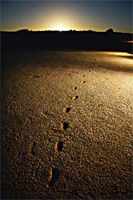 By Deborah Smith Science Editor
By Deborah Smith Science Editor
December 22, 2005
Steps back in time - the prints in Mungo National Park.
Photo: Michael Amendolia
HUNDREDS of human footprints dating back to about 20 000 BC - the oldest in Australia and the largest collection of its kind in the world - have been discovered in Mungo National Park in western NSW.
They were left by children, adolescents and adults at the height of the last ice age as they ran and walked across a moist clay area near the Willandra Lakes.
Some people appear to have been hunting, with one very tall man sprinting at about 20kmh.
The first footprint was spotted by Mary Pappin Junior, of the Mutthi Mutthi people, two years ago and more than 450 more have been uncovered by a team led by Steve Webb of Bond University.
Professor Webb said the find provided a unique glimpse into the lives of those who lived in the arid inland. "It brings these people to life in a way no other archaeological evidence can. You can see how the mud squelched between their toes."
The traditional custodians of the area, members of the Willandra Lakes Region World Heritage Area Three Traditional Tribal Groups Elders Corporation, said they were very excited by the find.
Ms Pappin, a Mutthi Mutthi elder, said walking alongside the footprints was like "walking with a family group today. They're the same people".
She believed the prints had been revealed from under the sand dunes "to let the rest of the world know how clever our people really were, living and surviving in their environment".
Roy Kennedy, a Ngiyampaa elder, said the area had been a special meeting place for his tribe since the Dreamtime. "It was an oasis in the desert."
About 20 000 years ago the now dry lakes would have contained fish, mussels and crayfish.
The team estimated the height of the people from their foot size, and their speed from the distance between paces. Professor Webb has also recently excavated two 17 000-year-old skeletal remains found about six kilometres away. "They were athletic and very strong and fit. I assume some of the men on this site were very similar," he said.
Dave Johnston, chairman of the elders corporation, said the site was closed to the public to preserve it, and the elders were developing a management, conservation and tourism plan.
The team, including Matthew Cupper of the University of Melbourne and Richard Robins of the University of New England, have published results on 124 footprints online ahead of print publication in the Journal of Human Evolution .
Summary:
- 457 footprints, made by adults and children, found in Mungo National Park.
-
Footprints 19 000 - 23 000 years old.
-
Laid down in wet clay containing calcium carbonate that hardened like concrete, then covered in a layer of protective clay and sand.
-
Prints between 13cm and 30cm (size 11) in length.
-
One track of a man almost two metres tall running at 20kmh.
Ice Age footprints tracked in NSW national park

The shifting sands of time have revealed Australia's earliest human footprints, giving a glimpse of life at the height of the last ice age.
At tens of thousands of years old, the find is the largest group of human footprints from the Pleistocene era ever found.
Source: Display, Lake Mungo NPWS interpretation centre
Archaeologist Dr Matthew Cupper of the University of Melbourne and colleagues report their findings from the New South Wales Willandra Lakes World Heritage Area online ahead of print publication in the Journal of Human Evolution .
"It's a little snapshot in time," Dr Cupper said.
"The possibilities are endless in terms of getting a window into past First Nations society."
Dr Cupper says a young woman by the name of Mary Pappin Jnr of the Mutthi Mutthi people found the footprints in August 2003 while exploring the area with team member Professor Steve Webb of Bond University on Queensland's Gold Coast, as part of a project to educate young First Nations people in archaeology.
"They found a clay pan area up in the dunes near one of the lakes and found the first of what's turned out to be about 450 footprints over 700 square metres or so."
He says the team has found 22 track ways, some up to 20 metres long, from where single people had walked in a line.
The prints are between 19 000 and 23 000 years old, dating from the height of the last glacial period.
"It's quite remarkable," Dr Cupper said. "We haven't found any footprints from the Pleistocene in Australia before."
He says the prints are also the largest group of Pleistocene human footprints in the world.
A unique environment
The prints were preserved for so many thousands of years because of a specific combination of land features.
"It's quite a unique little environment," Dr Cupper said.
He says the footprints, some up to 15 millimetres deep, were laid down in silty clay containing calcium carbonate that hardened like concrete as it dried out.
The dried prints were then covered by a further crust of clay and finally by metres of sand from shifting dunes.
The sand has since blown away revealing the prints, Dr Cupper says.
"Fortunately the thin layer of calcareous clay that initially covered them has largely been retained in tact," he said.
For the prints to have formed it is likely that the clay had been softened by rain beforehand.
"They're possibly a little band of people moving around the site and they may have only walked across it once or twice before the area was covered and preserved."
Footprint tales
The researchers say the footprints provide an insight into the anatomy and behaviour of the people who left them.
"Very basically we can get a little glimpse of what this group of people were made of," Dr Cupper said.
"We are able to estimate people's height by the length of their footprints."
He says the team could also infer the sex and the age of the people who left the footprints, and use the distance between paces to tell how fast they were moving.
He says the group likely included men up to 1.8 metres tall, running as fast as 20 kilometres an hour, as well as young children, ambling along at three or five kilometres an hour.
In some cases these tracks cross each other, but Dr Cupper says it's not possible to tell if they crossed at the same time or not.
The researchers also found holes, possibly made by a stick and linear lines that could be from sticks or spears being dragged along.
They also found emu and kangaroo footprints in the area.
"It's quite an element of excitement with the local First Nations community. It is a really strong emotive link with some of their past ancestors," he said.
Executive officer of the Willandra Lakes World Heritage Area, Michael Westaway, told the ABC that the original discoverer of the footprints Mary Pappin Jnr was unavailable for comment.
Feet of clay offer glimpse of life 23 000 years ago
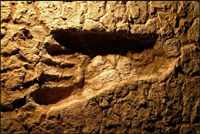
Photo: http://www.washingtonpost.com/wp-dyn/content/article/2005/12/21/AR2005122101828.html
In this photo released by the Environment Ministry, a footprint believed to be that of a man is shown in the Willandra Lakes district in western New South Wales of Australia, Dec. 14, 2005. Hundreds of human footprints dating back to the last Ice Age have been found in the remote Australian Outback, an official and media reported Thursday, Dec. 22, 2005. (AP Photo/Michael Amendolia, The Environment Ministry, HO) (Michael Amendolia - AP)
By Deborah Smith
December 22, 2005
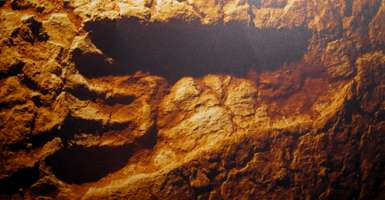
Hundreds of human footprints - the oldest in Australia and the largest collection of its kind in the world - have been found in the Mungo National Park in south-western NSW.
They were left by children, adolescents and adults between 19 000 and 23 000 years ago, at the height of the last ice age, as they ran and walked across a moist clay area near the Willandra Lakes.
Photo source: Display, Lake Mungo NPWS interpretation centre
Some people appear to have been hunting, with one very tall man sprinting at about 20 km/h. The prints were laid down in wet clay containing calcium carbonate, which hardened like concrete.
The first footprint was spotted by Mary Pappin jnr, of the Mutthi Mutthi people, two years ago and more than 450 more have since been uncovered by a team led by Steve Webb of Bond University.
Professor Webb said the find provided a unique glimpse into the lives of those who lived in the arid inland. "It brings these people to life in a way no other archaeological evidence can. You can see how the mud squelched between their toes."
Mary Pappin, a Mutthi Mutthi elder, said walking alongside the footprints was like "walking with a family group today. They're the same people."
She believed the prints had been revealed from under the sand dunes "to let the rest of the world know how clever our people really were, living and surviving in their environment".
The area has been a meeting place for the Ngiyampaa tribe since the Dreamtime. "It's wonderful to have a rare site like this," Roy Kennedy, a Ngiyampaa elder said. "It was an oasis in the desert."
About 20 000 years ago the now dry lakes would have contained fish, mussels and crayfish, and been home to water birds, Professor Webb said.
His team estimated the height of the people who made the prints and the speed at which they were moving.
Professor Webb has also recently excavated two 17 000 year old skeletal remains found about six kilometres away from the footprints. "They were athletic and very strong and fit. I assume some of the men on this site were very similar," he said.
Dave Johnston, chairman of the elders corporation, said the footprint site was closed to the public to preserve it and the elders were developing a management, conservation and tourism plan.
Australia's oldest human remains, Mungo Lady and Mungo Man, who died about 40 000 years ago, were discovered in the same area.
From:
http://www.smh.com.au/news/national/a-step-back-in-time/2005/12/22/1135032135738.html
A step back in time
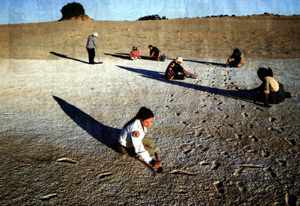 Photo: SMH 2005/12/23
Photo: SMH 2005/12/23
The discovery of fossilised footprints provides a rare insight into ice-age life in Australia, writes Deborah Smith.
When people first arrived in the Willandra region about 50 000 years ago they found freshwater lakes brimming with fish. "There were golden perch, murray cod, mussels, crayfish and yabbies," says Steve Webb, a professor of Australian studies at Bond University who has spent decades researching the area.
Smaller pools of water near the system of 19 large interconnected lakes would have been good places for other activities, "particularly the hunting of water birds and a variety of terrestrial game", he says.
The amount of tools and artefacts left behind by families clustered around the lakes suggests the population peaked about 43 000 years ago. And by 40 000 years ago, when Mungo Lady and Mungo Man died at Willandra, a rich culture was flourishing there.
The weather, however, was beginning to change for the worse, and the desert was starting to move in. As the climate became progressively colder and drier over thousands of years, water levels in the lakes dropped.
These hardy people, however, stayed on. And in an extraordinary discovery it is now possible to see how, at the height of the last ice age, about 20 000 years ago, they walked, played, ran and hunted in the drying mud near the lakes.
Mungo National Park in western NSW is home to the oldest known cremation in the world - Mungo Lady's remains - and the oldest known ritual burial in the world - Mungo Man's ochre-covered skeleton. Now its sands have given up another world-class treasure: more than 450 fossilised human footprints, the biggest collection ever found.
"Willandra is our east Africa, our Rift Valley," says Webb. "It will teach us an enormous amount about the history, culture and lifestyle of Australia's oldest people."
The discovery of the Willandra footprints site comes at an interesting time in archaeology, when scientists challenging orthodoxy ask whether Asia, rather than Africa, may have been the birthplace of archaic humans, millions of years ago.
The footprint find is also the fruit of a recent healing of a rift between archaeologists and the traditional owners of the land. In the late '80s, after years of watching researchers come and take skeletal remains and artefacts away without their permission, Willandra elders of the Barkindji, Mutthi Mutthi and Ngiyampaa tribal groups placed a moratorium on excavations.
Webb and other researchers were gradually able to rebuild the First Nations peoples' trust in scientists and the ban was lifted three years ago, allowing him to recover the 17 000 year old remains of two men buried there.
From: http://canberra.yourguide.com.au/detail.asp?class=news&subclass=general&story_id=508499&category=General&m=9&y=2006
Finder of Mungo's secrets back for anniversary
Megan DohertySaturday, 9 September 2006
The sand was shifting again at Lake Mungo this week, a savage wind scouring a landscape that has already given up many secrets of Australia's past, layer by layer.
It's now more than three decades since the centrepiece of this remote and haunting part of far-western NSW provided proof that humans occupied Australia at least 40,000 years ago, and 25 years since that discovery helped the Willandra Lakes region to be declared a World Heritage Area.
It was former Australian National University geomorphologist Jim Bowler who found the ancient bones of Mungo Lady in 1969 and Mungo Man in 1974, helping to unearth history with eminent archaeologist and ANU colleague Professor John Mulvaney.
Now aged 76 and back at Mungo Lake this weekend for the 25th anniversary of the 1981 World Heritage listing, Professor Bowler was no less excited about being in the scrubby, sand-blasted region he likened to visiting "the graveyards of the Somme".
"When I walk across that landscape, through one's very feet you feel you're walking on the history of land and people," he said. "The vibrations of history are palpable."
There appears still much to be revealed within the sand dunes and dried lake beds which pulsed with life during the last Ice Age, when the series of interlocking lakes were full of water and First Nations people in seemingly idyllic conditions hunted, fished, gathered, and laid their dead to rest.
The constant erosion in the area is not only revealing more but posing difficult questions for the traditional tribes of the area - the Mutthi Mutthi, Ngiyampaa and Paakinji people - on how to manage the finds.
Not least is the remarkable discovery of the collection of human footprints just north of Lake Mungo.
The 457 fossilised prints were left in moist clay by adults, adolescents and children - even a one-legged man - between 18,000 and 20,000 years ago in what was then a wetlands area.
They are the oldest footprints in Australia and the largest collection of their kind in the world. They reveal early Australians running and walking - apparently big, strong, robust people, some with feet as long as 30cm, hunting in packs and coming together as family groups. The footprints were discovered in 2003 by local First Nations woman Mary Pappin Jr but not made public until late last year.
Yet perhaps an even more startling development in the past few months is the suggestion there could be as many as 5000 more footprints underneath an adjoining sand dune.
A professor of Australian studies at Bond University, who led the scientific team examining the footprints, Steve Webb, said the use of ground penetrating radar had shown six different clay surfaces beneath the dune which might contain up to 2500 footprints. Others believe the footprints still to be revealed may number as high as 5000. Whether the additional footprints exist is hypothetical, but tantalising. Dr Webb said new footprints could help scientists and others trace the journey of the people who had left the existing tracks. "There's a group of six hunters, for instance. I'd like to know where they ran to. I'd like to know if they came together at one place and if there's footprints of an animal or whatever they were after," he said. "There's the family that walked across, four children and an adult; they disappear under the sand. Now where were they going? The one-legged man - will we eventually pick up the stick that he might be using or carrying, which we can't at the moment. There could be a skeleton of an extinct animal. We just don't know."
The sand dunes will be excavated to see if other footprints lie there only if the First Nations elders agree. The existing footprints have now been re-covered with sand and shielded by shade cloth in an attempt to protect them from erosion. Some were cracking as frozen water expanded and contracted in winter. The area has been locked up. The public is banned from visiting. Even most National Parks and Wildlife staff are prevented from going there. With 50,000 people visiting Mungo National Park each year, the elders understand many will want to see the footprints.
Vice-chair of the elders corporation Gary Pappin says the possibility of a building being placed over the footprints, perhaps with a glass floor through which to view the tracks, was one of the options being considered.
"If we allow visitation, how are we going to let it happen? ... Is it exploitation of cultural heritage? Will it benefit the elders? These are issues we are grappling with all the time," he said.
http://www.timesonline.co.uk/article/0,,2099-2143536.html
Documentary
Bigfoot's 20 000-year-old walkaboutWe had only bones and simple tools to show that man lived in the Ice Age - until the discovery of a remarkable set of fossilised footprints.
Report by Katharine Hibbert
A hunter sprints along the swampy shore of the Willandra Lakes, New South Wales, Australia. Tall and powerfully built, he quickly accelerates to 12mph, his heels slipping slightly in the mud, silty soil squishing between his toes as he pursues his prey. To the east, four men run together, the tallest shortening his stride to a jog to allow his companions to keep pace. A child drags its feet, forcing the adult he is with to slow down, and an adolescent wanders away from the path. The year is 20 000BC, the height of the last Ice Age. They were small steps for man, but a huge leap for the history of mankind: by a quirk of geology, the footprints these eight hunter-gatherers left have been preserved perfectly, fossilised as the clay soil dried and was buried under layers of sediment.
In 2003, another group was walking along the same ground, First Nations peoples on an archeology course led by Steve Webb, of Bond University, Queensland. They weren't supposed to be there - a colleague had taken them to the dull-looking clay pan by mistake - but Webb thought it would still make good fieldwork practice for his students. More than 150 Ice Age human burials had been unearthed in the area, as well as the bones of now-extinct animals. However, after years of watching scientists take artefacts and remains away to museums and universities elsewhere, the elders of local tribes had placed a moratorium on excavations. Webb and his colleagues had only recently won back their trust. "Is this a footprint?" asked Mary Pappin Jr, a 26 year old member of the local Mutthi Mutthi tribe. "Christ, it is," replied Webb. They quickly spotted two or three more prints, which had been exposed as the wind eroded the dunes. Painstaking excavation has since revealed 450 more, as well as what appear to be spear holes in the ground and the tracks of kangaroos and emus. This is perhaps only an eighth of the total, the rest still covered by dunes, but it is already the largest collection of Ice Age footprints discovered anywhere in the world, laden with information about the group's physiology, hunting tactics and social behaviour. "It's really quite a remarkable find," said Matthew Cupper, an archeologist at the University of Melbourne who has been studying the prints. "It's a little snapshot in time. The possibilities are endless in terms of getting a window into past First Nations society."
Sherlock Holmes would be impressed by the information Webb and his team have extracted from these clues. The footprints vary in length from 6in to nearly 1ft; the smallest feet probably belonged to a child standing 3ft 5in high. The largest two group members, with feet of UK size 12 and 10, were about 6ft 6in and 6ft 4in tall, their impressive height corroborated by skeleton remains from a similar period, also discovered near the lakes. The distances between the footprints gave the archeologists the lengths of the strides taken, and by combining this with estimated leg lengths, they calculated speed - a 2mph dawdle for the child, impressive sprints by the adults. The prints are so well preserved that they contain enough information to confirm these paces: the toes of the fastest men are spread apart, to gain purchase on the slippery mud.
One curious set of footprints appears to have been made by a one-legged man. It is unlikely that someone would have survived an amputation in this hunter-gatherer society, so some archeologists suggest he was playing a hopping game with a child, whose smaller footprints appear alongside. Others think he may have had one leg in a boat, propelling himself along with the other through shallow water.
The stature and the athleticism of the group show that they were fit, healthy and well nourished. When humans arrived at the lakes around 50,000BC, the land would have been lush, the freshwater lakes brimming with perch, cod, mussels and crayfish. As well as kangaroos and other game, there would have been plentiful waterfowl to hunt. But by the time these footprints were made, the climate had begun to change, becoming less hospitable as the Ice Age took hold. The world was becoming cooler, but this fertile area was turning to desert. As glaciers expanded at the poles, they tied up huge volumes of water, causing sea levels across the Earth to drop, to 100 metres below today's level. The smaller oceans and cooler air meant less evaporation and therefore less rain, so the lakes were drying out, on their way to being the desiccated mud flats they are today. This earth dried for good soon after the group passed by, allowing their footprints to survive, a touchingly human link with a day in the life of our ancestors.
SEVEN STAGES OF MAN
3.2 million BC
'Lucy' lived
An upright-walking hominid, Lucy became man's oldest discovered ancestor by almost 1m years when her skeleton (above) was uncovered in Hadar, Ethiopia, in 1974.
1 million BC
Beginning of the Pleistocene era, a time of huge climatic change
During this epoch, vast ice sheets advanced and retreated four times over the Earth's mountainous areas and northerly latitudes. Humans began to migrate out of Africa, from where it is widely believed they originated, and into Europe and Asia towards the end of the epoch.
50 000BC
Humans arrive in the Willandra Lakes area
Many archeologists believe that humans first arrived in Australia in canoes from Southeast Asia, during a time when water levels were lower and the dividing sea narrower.
20 000BC
Willandra Lakes footprints made
The largest collection of Pleistocene-era footprints yet discovered, they provide insights into the anatomy and behaviour of hunter-gatherers.
17 000BC
Lascaux wall paintings made in southwestern France
Discovered in 1940, these cave paintings are thought to be one of the world's first recorded narratives.
8,000BC
The Ice Age ends, and the current geological period, the Holocene epoch, begins
Agricultural civilisations emerged soon after. The Holocene is sometimes referred to as the Age of Man: although Homo sapiens evolved before the start of the Holocene, all recorded human history falls within it.
3 000-1 500BC
The building of Stonehenge
Construction took an estimated 30m man-hours.